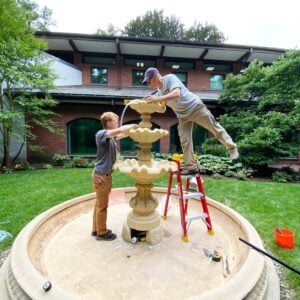There’s something quite refreshing about the sight and sound of a fountain, the splish-splash of cool water on stone, don’t you agree? Mary Baker Eddy certainly enjoyed an occasional respite by the burbling fountain on the grounds of Pleasant View, her home near Concord, New Hampshire.1
And, just steps from their desks and offices here at Longyear, our own staff have appreciated a similar amenity in our back courtyard for nearly 25 years. A generous gift soon after the Museum was first built, a multi-tiered fountain enhanced the beauty and peace of this courtyard garden during many a lunch break or ad hoc meeting (and helped muffle the sounds of traffic on an adjacent thoroughfare).
However, after nearly a quarter century of summertime operations, the fountain was showing signs of wear and tear, recalls Executive Director Sandy Houston, and was ready for a new pump and basins. (From late fall to early spring, the water is turned off and the entire fountain is enclosed in a tepee-shaped frame for protection from the elements.)
The fountain was on Longyear’s 2023 agenda of “capital” projects, but so were many other items—a new shingle roof for the Mary Baker Eddy Historic House in Stoughton, final restoration of 400 Beacon Street, and parking lot paving and an HVAC upgrade at the Museum.
Given the multiple items for which Longyear typically needs to fund-raise to support the mission of telling Mrs. Eddy’s story, the Development Office wondered if the staff might be interested in taking on the fountain repair as their own “capital project.” As Development Associate Noah Ostler explains, the notion grew from the fact many staff already donate to Longyear on a regular basis. The fountain project could enable them to be “a little more focused and selective” with any contribution they planned to make during the year.
The idea was pitched at a staff meeting to positive reception, and a follow-up email reiterated that participation was completely voluntary and confidential. The email shared the Development team’s underlying trust and conviction that “the funding for all our capital projects … will be met as there is only one source of supply!” And the message closed with a sincere acknowledgement to staff that “your diligent work is the greatest gift of all!”

Contributions began to flow in right away. Between one-off gifts, monthly payroll deductions, and giving pledges, the initial goal of $8,000 was soon reached.
After obtaining quotes, a contractor was selected to produce a new trio of tiered basins and a new pump was purchased. The stonework took several months and was finally delivered to the Museum grounds in mid-summer. Further adjustments by the contractor followed by unusually rainy weather delayed re-installation a little further. Finally, in late August, Paul Paradis and Peter Griswold, members of Longyear’s skilled facilities team, were able to tackle the task.
Now, once again, Longyear staff—as well as day visitors, guests on our extended house tours, and those attending Christian Science Association meetings at the Museum—are able to enjoy the gentle fall of water. More than a “capital” project, this fountain restoration can be viewed as a “commitment” project—highlighting the deep regard and love that the staff have for Longyear’s mission of preserving and sharing the history of the Discoverer, Founder, and Leader of Christian Science.